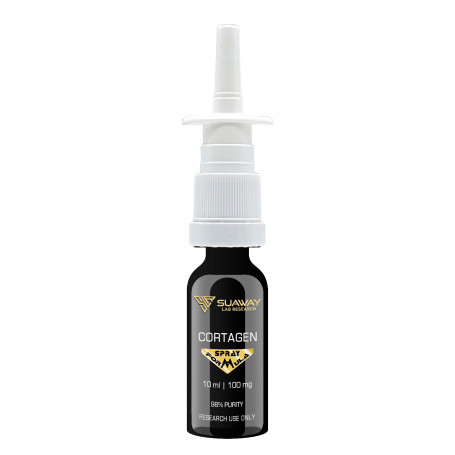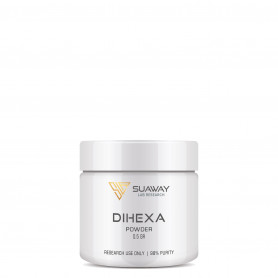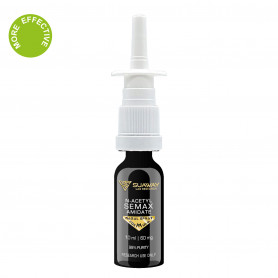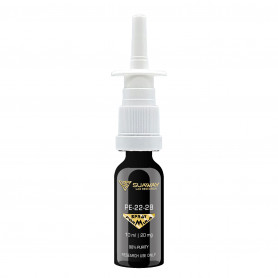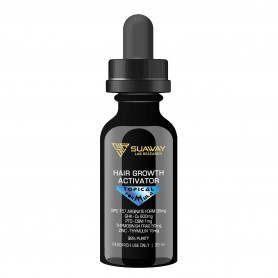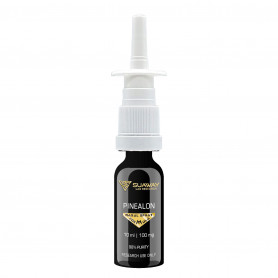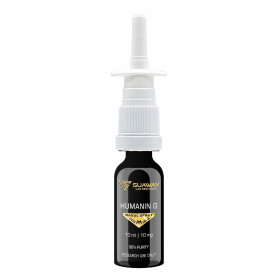CORTAGEN - 10ml/100mg
It is possible to make use of Cortagen in order to activate brain reparative processes, cerebroprotective activity, and nootropic activity in order to cure and prevent cerebral degenerative illnesses such as the following:
- Cerebral lesions
- Alzheimer's disease, Pick's disease, senile dementia, cerebral degeneration, Jacob-Creutzfeldt disease, atherosclerotic dementia and hydrocephalus;
- Parkinson's disease and other extra pyramidal disorders;
- Spinal-cerebellum disorders;
- HIV-encephalopathy, multiple sclerosis;
- Treatment and prevention of hemiplegia;
- Paralytic syndromes;
- Cerebral impairments in case of bacterial meningitis;
- Cerebral haemorrhage;
- Cerebral ischemia.
Total Spray: 82 (1,22 mg per spray)
FRESHLY PREPARED SOLUTION
Beschreibung
STRUCTURE
Sequence: L-Ala-L-Glu-L-Asp-L-Pro
Molecular Formula: C17H26N4O9
Molecular Weight: 430.41
Peptide purity: greater than 98%
Other details: No TFA Salt, No Mannitol
Storage: This product must be stored at 4°C. No suitable for freezing.
DESCRITPION
The natural brain cortex peptide preparation Cortexin was analyzed for its amino acid composition, which allowed for the guided synthesis that led to the production of the synthetic tetra peptide Cortagen (Ala-Glu-Asp-Pro). When compared to Cortexin, Cortagen was shown to have fewer impacts on anxiety-related behavior while simultaneously enhancing locomotion both during and after acute and sub-chronic therapy.
Acute administration of the Cortagen produces effects similar to those of an anxiolytic. Acute and sub-chronic Cortagen administration results in motor stimulation without any adverse effects on the emotional and affective profiles of the patient.
The process of aging is linked to major changes in the way genes are expressed in a wide variety of organs and tissues. Because anti-aging treatment using peptide bio regulators have a great deal of promise for the correction of age-associated alterations, screening for their molecular targets in tissues has become an important concern in contemporary gerontology.
Cortagen was shown to have a significant therapeutic impact on the structural and functional posttraumatic recovery of peripheral nerve tissue in human patients. It's important to note that additional impacts were seen in cardiovascular and cerebrovascular measures as well. There is speculation that Cortagen is a physiologically active chemical that may stimulate the operational activity of neurons. It is suggested for delivery through the parenteral, intranasal, and oral routes.
The method of stimulating the functional activity of neurons involves the administration of the peptide in doses ranging from 0.01-100 micrograms per kilogram of the subject's body weight at a frequency of at least once per day for the amount of time required to achieve the desired therapeutic effect.
Cerebrolysin is another kind of non-protein cerebral hydrolysate that is known to exist. It is a composed of free amino acids and low-molecular peptides. The aforementioned substance boosts the efficiency of aerobic energy metabolism, enhances the synthesis of proteins inside cells, demonstrates neuroprotective and neurotropic action, and has a beneficial impact if cognitive changes take place. One of the problems with the aforementioned compound is that the neurotropic effects it produces are not as strong as those produced by the body's own naturally occurring neurotropic components. The administration of the medicine does not give a significant amount of restoration of the anatomical structure and functional activity in neurons that have been injured in the cerebral and spinal regions. The use of cerebrolysin could result in certain unwanted side effects. In addition, acute renal failure is a condition that should not be treated with the aforementioned agent.
Endogenous peptide compounds in the central nervous system are known to operate as signal transducers in the transfer of information from interneurons or neuroeffectors, and they are also capable of performing the roles of neurohormones, neurotransmitters, and neuromodulators. These endogenous molecules, known as neuropeptides, are released from the neural components that are responsible for communication so that a target structure may recognize them as information. It has been discovered that neuropeptides are a way of integrated regulation of the activities of the central nervous system, such as the processes of repair, memory, emotional activity, perceptions of pain and pleasure, and so on.
Cortagen demonstrates biological activity and, more specifically, stimulates the neuronal functional activity in both the central and peripheral nervous systems. This is accomplished by normalizing metabolic processes, stimulating antioxidation defense parameters, and improving electrophysiological indices. The peptide that restores metabolism and promotes development in damaged nerve tissue structures is the one that stimulates neuronal functional activity.
Effect of Cortagen on the Intensity of Lipid Peroxide Oxidation Reactions in the Cerebral Cortex
It was discovered that the use of Cortagen has a considerable suppressive effect on the production of LPO products in the cerebral cortex. According to the findings obtained, the administration of L-Ala-L-Glu-L-Asp-L-Pro tetra peptide prevented the development of oxidation products of lipid peroxide and protein peroxidation in the cerebral cortex.
Effect of Cortagen on Repair Processes in the Brain after a Craniocerebral Injury
On a model of acute severe craniocerebral damage, the effect of the L-Ala-L-Glu-L-Asp-L-Pro tetra peptide on the repair processes in the brain was evaluated. Tests on the animal's ability to acquire and reproduce conditioned reflex skills, as well as their coordination of movements and muscle tonus, were used to determine the dynamics of the functional restoration of the central nervous system. A falling lead weight was the culprit behind the severe craniocerebral compression that the rats experienced.
Cortagen was administered intramuscularly into the experimental animals at 1, 12, 48, and 96 hours after the first injection. Cerebrolysin was administered to the animals who were part of the second group. After a period of 48 hours, none of the surviving animals regained their capacity to be trained. After 96 hours, the rats that had been treated with Cortagen had twice as many trainable animals as the rats that had been used as controls. At the end of the first month, the indicators of learning in the rats that had been injected with tetra peptide were likewise greater than those in the control group. The severe craniocerebral damage caused the animals to exhibit prominent symptoms of asthenoneurotic syndrome, which resulted in a reduction in the animals' coordination as well as their muscle tonus. The "rotating pivot" test indicated that the use of Cortagen aided in the restoration of movement coordination and muscle tonus within forty-eight hours after the traumatic event (the time of retention on the pivot twice exceeded that in control). In cases of severe craniocerebral compression, the effectiveness of cerebrolysin was lower than that of Cortagen.
Therefore, the administration of Cortagen resulted in a considerable improvement in the animals' capacities for learning and the replication of conditioned reflex skills. Additionally, it resulted in the restoration of the animals' coordination of movements and muscle tonus. On the fourth day following the traumatic event, the beneficial impact of the tetra peptide was already apparent. On the thirteenth day, the indices of learning were getting closer and closer to the usual levels. In the event of a severe acute craniocerebral injury, the populations of neurons located in the grey material of the brain are rendered dysfunctional and eventually destroyed. It was shown that the current tetra peptide encouraged reparative processes in the brain by the fact that the accelerated restoration of the central nervous system functions in the early posttraumatic period as a result of the influence of Cortagen.
Effect of Cortagen on the Regeneration of the Compressed Peripheral Nerve
The experiment was carried out on a total of 22 inbred white male mice that ranged in weight from 25 to 30 g. (7 experimental and 15 control animals). The mice were subjected to continuous operations during the first stage of the investigation to exert pressure on the fibular nerve. After that, beginning on the third day after the nerve compression, the mice received daily intraperitoneal injections of Cortagen at a concentration of 10 micrograms per kilogram for the next eight days. The mice serving as controls were given an equal volume of saline as their treatment. On the 11th day after the nerve compression surgery (and within 24 hours after the last tetra peptide injection), mice were tested electro physiologically in vivo for various functional parameters of the already germinated nerve and innervated skeletal muscular fibers. These tests were performed by researchers at the University of California, San Francisco (EDL).
The data that was collected suggested that by the 11th day after nerve compression, Cortagen increased the restoration of the excitability threshold and promoted corresponding changes in the "strength-duration" curve for the regenerating neuromuscular system. This was observed in the context of the regenerating neuromuscular system. This indicates that the administration of Cortagen substantially and noticeably increases (by 30–50%) one of the primary functional indicators of the regenerating nerve, which is that nerve's electric threshold, hence speeding the time it takes for the nerve to return to its normal values.
The administration of the L-Ala-L-Glu-L-Asp-L-Pro tetra peptide sped up the restoration of a variety of significant functional indicators in the nerve that was regenerating after being compressed. When this occurred, the tetra peptide encouraged regeneration in both the nerve and the muscle, bringing them closer to the condition that is typical of intact, "healthy" emotional units. Therefore, as a result of the experiments that were carried out, it was discovered that L-Ala-L-Glu-L-Asp-L-Pro tetra peptide was non-toxic, capable of stimulating activity of the cerebral neurons, which resulted in a marked cerebroprotective action, metabolic activation, and high neurotropic activity.
Efficacy of Cortagen in the Treatment for Vascular Dementia
Twelve patients with hypertensive illness and atherosclerosis of cerebral arteries who had been experiencing these conditions for an extended period were recruited in the research. There were seven males and five females in this age range. A history of apoplexy was found in the medical records of three of them. The control group consisted of the initial data gathered from patients who were comparable to the patients being treated. Cortagen was administered intramuscularly in a single dosage of 3 micrograms once a day for a period of 30 days. The data collected before the therapy were compared to the data obtained after the treatment was completed, and the results of this comparison were evaluated. Based on the findings of the examination, the progression of the patient's conditions was graded as follows: improvement (significant, average, or slight), deterioration, and no changes.
At the pretreatment examination, symptoms of intellectual and mnemic deficiency were discovered in all of the patients. These indicators included memory impairment, intellectual degeneration, and disorders of aphasia, apraxia, and agraphia. Nine individuals showed evidence of being disoriented in both time and location. The patient's emotional state was unstable, as seen by occasional shifts between apathy and exhilaration, complacency and anger aptness, and so on. The results of the psychological test revealed that the individual had significant memory problems as well as aphasia, which is the inability to effectively engage in intellectual activities.
By the fourth or fifth day, the clinical condition had begun to improve. There was a reduction in the patient's emotional instability, as well as an improvement in their activity level as well as their desire to take some kind of action. After five to seven days, the patient's sleeping pattern returned to normal, they had less weariness during the execution, and they improved their ability to navigate their surroundings. Amnesia, aphasia, and apraxia showed less evidence of their presence. In addition to this, both their capacity to remember recent happenings and their ability to recall experiences from the past increased. The alterations in their emotional state were dependent on their emotional history before this point. Patients who were depressed said that their mood had improved, accompanied by an augmented general tonus and a better physical condition. Indifferent patients reported that they were more active. In instances of emotional liability and increased irritation, the patients' emotional states were more stable as the therapy progressed, indicating that the treatment was successful.
Examinations utilizing neuropsychological and psychophysiological methods revealed that the activity of the tetra peptide led to improvements in short-term memory, as well as an increase in the quantity of material that was memorized and the ability to concentrate. In addition, the patients demonstrated a reduction in the amount of time needed to do mathematical calculations, in addition to a reduction in the number of errors made. Following completion of the prescribed therapy, the patients exhibited a discernible improvement in their capacity for sustained attention, as well as enhanced parameter values for difficult sensorimotor reactions including selection.
Because of this, the preliminary clinical trial of L-Ala-L-Glu-L-Asp-L-Pro tetra peptide in patients with vascular dementia showed a significant therapeutic effect of the preparation. This was demonstrated by the fact that during the course of applied treatment with low drug dosage, 74.8 percent of the patients showed a reverse development of pathologic symptoms. The findings that have been exhibited suggest that L-Ala-L-Glu-L-Asp-L-Pro tetra peptide has a high degree of success in the treatment of cognitive impairment, memory and attention difficulties, aphasia, apraxia, and emotional disorders in individuals who have vascular dementia.
It is possible to make use of cortagen to activate brain reparative processes, cerebroprotective activity, and nootropic activity to cure and prevent cerebral degenerative illnesses such as the following:
- Treatment and prevention of trauma-associated cerebral lesions including: treatment for cerebral lesions after a fracture of the cranial vault, skull base, multiple bone fractures
- Treatment for the cerebral lesions in cases of intracranial trauma (posttraumatic cerebral concussion, cerebral wounds and contusion, subarachnoid, subdural and extradural haemorrhage)
- Treatment and prevention of traumatic shock
- Treatment for the cerebral lesions associated with the impact of radiation, lowered temperature, electric and ultrahigh frequency current
- Treatment and prevention of delayed-onset effects of skull fractures
- Treatment and prevention of delayed-onset effects of intracranial trauma
- Treatment for the cerebral lesions after poisoning with therapeutic agents, medicinal and biological compounds
- Treatment and prevention of delayed-onset cerebral lesions induced by poisoning with drugs and non-medical substances
- Treatment and prevention of pediatric cerebral degenerative disorders
- Treatment and prevention of Alzheimer's disease, Pick's disease, senile dementia, cerebral degeneration, Jacob-Creutzfeldt disease, atherosclerotic dementia and hydrocephalus
- Treatment and prevention of Parkinson's disease and other extra pyramidal disorders
- Treatment and prevention of spinal-cerebellum disorders
- Treatment and prevention of HIV-encephalopathy, multiple sclerosis, and polyarteritis nodosa
- Treatment and prevention of hemiplegia
- Treatment and prevention of infantile cerebral paralysis
- Treatment and prevention of other paralytic syndromes
- Treatment and prevention of cerebral impairments in case of bacterial meningitis including cryptococcus meningitis in AIDS patients
- Treatment and prevention of cerebral impairments in case of non-bacterial meningitis
- Treatment and prevention of cerebral impairments in case of subarachnoid haemorrhage
- Treatment and prevention of cerebral impairments in case of cerebral haemorrhage
- Treatment and prevention of cerebral impairments in case of occlusion of cerebral arteries
- Treatment and prevention of cerebral impairments in case of transitory cerebral ischemia.
REFERENCES
S. Korsching "The neurotrophic factor concept: a reexamination" [The Journal of Neuroscience]
V. Khavinson et al., "Tetrapeptide stimulating functional activity of neurones, pharmacological agent based thereon and method of use thereof" [USP]
L.N. Turchaninova et al., "Effect of tetrapeptide cortagen on regeneration of sciatic nerve" [PubMed]
D.V. Kurkin et al., "Neuroprotective action of Cortexin, Cerebrolysin and Actovegin in acute or chronic brain ischemia in rats" [PubMed]
Shabanov, Vislobokov "Neuronoprotective action of cortexin and cortagen" [Reviews on Clinical Pharmacology and Drug Therapy]
DISCLAIMER
This product is intendend for lab research and development use only. These studies are performed outside of the body. This product is not medicines or drugs and has not been approved by the FDA or EMA to prevent, treat or cure any medical condition, ailment or disease. Bodily introduction of any kind into humans or animals is strictly forbidden by law. This product should only be handled by licensed, qualified professionals.
All product information provided on this website is for informational and educational purposes only.

